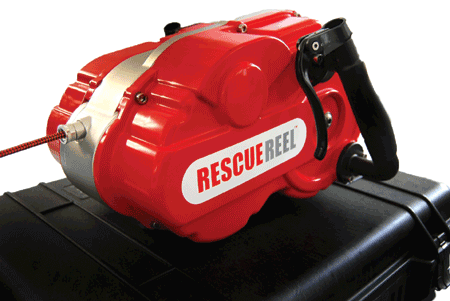Surgeon turns attention from saving knees to saving lives in high-rise disasters
‘Rescue Reel’ personal egress device can be a lifesaver to those stranded on high floors.
As a practicing orthopedic surgeon based in San Francisco with around 50 U.S. patents to his name, Kevin R. Stone, MD, is no stranger to invention. Still, it’s one of his latest works — created alongside a design team from Stanford University – that is getting national recognition.
The Rescue Reel, a life-saving device that enables people to escape endangered buildings up to 100 stories tall, was named one of the best inventions of 2009 in Popular Science’s Inventions of the Year issue.
The device stores up to 1,000 feet of cord and, in the event of an emergency, allows potential victims to lower themselves to the ground safely and securely in less than a minute. Its self-adjusting braking system lowers users at a rate of 6 feet per second.
“An obvious solution”
According to Stone, the idea behind the Rescue Reel’s creation formed as one of the United States’ greatest tragedies unfolded.
“Like most people, I was disgusted by watching people hold hands and jump out of the towers on 9/11,” Stone told Orthopedics Today. “I thought, if I can reel in a 400 lb. fish, I ought to be able to reel out a 400 lb. person.”
The oft-broadcasted images of victims leaping to their deaths out of the World Trade Center towers spoke directly to Stone, who talked of his natural inclination toward helping others.
“You see a tragedy like that happen, and if you are someone like me who likes to solve problems, you say to yourself, ‘I want to solve that problem,’” he said. “It just seems like such an obvious solution … people say it seems so obvious. They are curious about why it had not been available before.”
Advanced, but easy to use
At its base, the Rescue Reel is a simple device — Stone compared it to a fishing reel.
“I had worked with a design team from Stanford called Think2Build … on a previous engineering design,” Stone said. “I called them and laid out the design for a fishing reel-type device, so that a person could reel themselves out. That is how it got started.”
Though the core of the device is simple, the design and mechanics involved are advanced. “The reel has a centrifugal braking device, so anyone of any weight — be it a 50 lb. child or a 400 lb. person, will be lowered at the same rate,” Stone said. “There is also a hand brake, in case you want to slow yourself down or stop for some reason.”
“The idea is that somebody who is in a panicked state could use it without any training,” he added.
He compares it to an AED device. “If you open the top of the box there will be five easy steps to follow in order to use it,” he said. “The first would be to hook the end of it to something that will not go out the window, such as a doorframe or a desk. Then, you step into a universal harness. Then, open or break a window or a roof hatch and hold on to the Rescue Reel device itself, which is hooked to the harness.”
|
Image: Stone KR |
Not just for skyscrapers
Though the Rescue Reel could most obviously help those who happen to be in skyscrapers during a time of emergency, Stone said the device’s range goes beyond buildings of that height.
“I think anybody living in a condominium tower or working in an office space or in a hotel above the level which the fire trucks can get to — which is usually six stories — might benefit from having one,” he said. “It is small enough to fit in a file drawer.”
“It is also useful for mountain rescue,” he added. “If someone is stuck on a cliff, rather than lowering a fireman down to help them get off, you could lower a Rescue Reel to them.”
The Rescue Reel was successfully tested in January by the Vallejo, CA, fire department. Stone said support for the device was prevalent within the fire department itself.
To help as many as possible
Stone said he expects demand for the device to increase over time.
“I think if there is, unfortunately, another accident, or an earthquake, peoples’ attention span for personal egress devices will increase,” he said. “A number of cities may require new codes for personal egress devices.”
While the Rescue Reel’s future is certainly promising, Stone said he’s focused primarily on the idea of helping as many people as possible.
“I think the kinds of problems we work with and the kinds of people we work with all the time … as an orthopedic surgeon, stimulate us to solve all kinds of problems,” he said. “I think that is just who I am.”
“Contributing is our mission in life,” he added. “It is extremely satisfying.”
For more information:Kevin R. Stone, MD, is an orthopedic surgeon with the Stone Clinic in San Francisco. He can be reached at The Stone Clinic, 3727 Buchanan Street, San Francisco, CA 94123; 415-563-3110; e-mail: kstonemd@stoneclinic.com.
Plans, videos and news regarding the Rescue Reel can be found at Rescue Reel, Inc.’s Web site: http://www.rescuereel.com.

